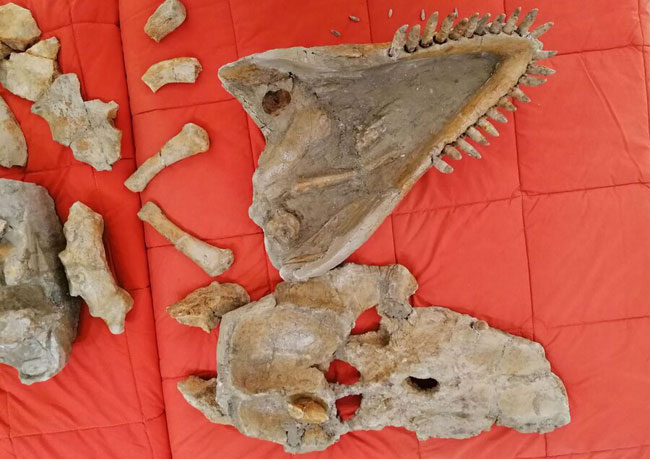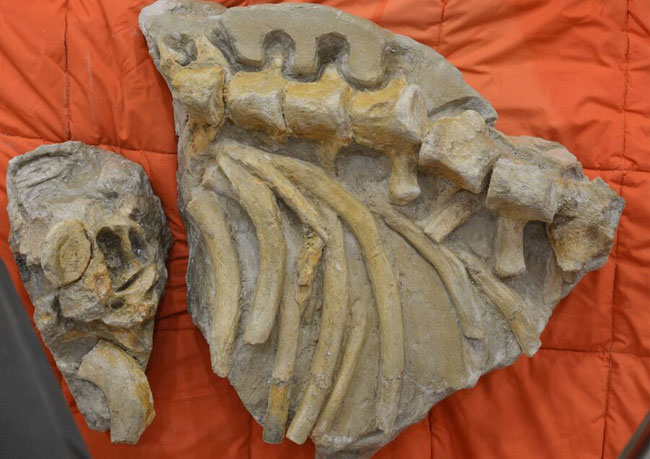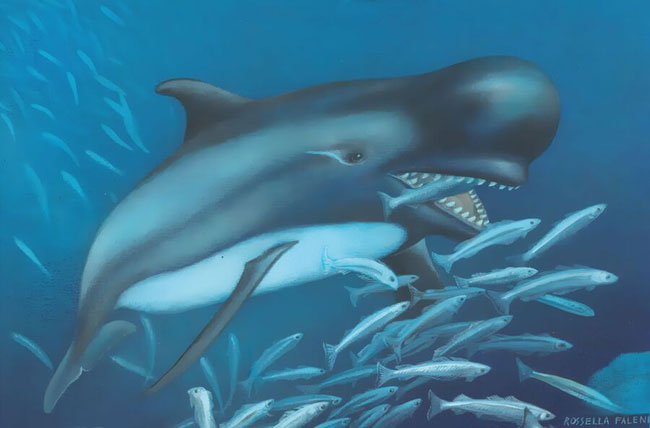Only two living species of dolphins (members of the Delphinidae family), are known to attack and feed upon large mammals. There is the killer whale, also referred to as the Orca, (Orcinus orca) and the false killer whale (Pseudorca crassidens). Orcas attack a wide variety of other marine mammals including seals, sealions, whales and other dolphins, whereas the false killer whale mainly eats fish but attacks on smaller dolphins, sperm whales and the young of baleen whales have been reported.
When did this feeding behaviour evolve? The fossilised remains of a newly described killer whale (Rododelphis stamatiadisi) which is believed to be the closest relative to both O. orca and P. crassidens may provide an answer. The fossils of R. stamatiadisi were found in Pleistocene strata aged between 1.5 and 1.3 million years old on the Greek island of Rhodes, traces of the last meal consumed were found, fish – blue whiting. This suggests that macropredation in members of the Delphinidae evolved relatively recently.
Comparing Two Ancient Whale Fossils Found Centuries Apart
Researchers from the University of Pisa (Italy) and the New York Institute of Technology (USA), analysed the fossil remains from Rhodes, discovered in 2020 and compared them to the fossils of Orcinus citoniensis, from Pliocene-aged deposits in Tuscany (Italy). The O. citoniensis fossils, consisting of partial postcranial material, skull and jaw bones were first described in 1883 by the famous Italian palaeontologist Giovanni Capellini.
Co-author of the Rododelphis paper, published in the academic journal “Current Biology”, Sara Citron (University of Pisa), had just finished her master’s thesis on Orcinus citoniensis. Microwear on the teeth was consistent with a diet of medium-sized fish, so although Orcinus citoniensis had a body length in excess of four metres, it probably did not specialise in hunting other marine mammals.
The Rododelphis material was discovered in the Bay of Pefkos on the south-eastern coast of the island by Polychronis Stamatiadis, an expert in the geology and palaeontology of Rhodes. Analysis of these fossils revealed five otoliths (calcium carbonate structures found in the inner ear of fish) from Micromesistius poutassou (blue whiting) which indicates that the last meal of this extinct cetacean was fish.

Although estimated to have been around five metres long, R. stamatiadisi, like Orcinus citoniensis, was probably not a hunter of other marine mammals.
Evolution of Macropredation not Linked to Gigantism in Baleen Whales
Anatomist and co-author Jonathan Geisler (New York Institute of Technology), carried out an phylogenetic assessment and identified that Rododelphis was a close relative to Pseudorca crassidens as well as the extinct Orcinus citoniensis, which in turn was closely related to the living killer whale.
Dr Geisler explained:
“Our study supports the hypothesis that the Rhodes dolphin [R. stamatiadisi] and the Italian Orca [Orcinus citoniensis] represent two similar, but separate, evolutionary stages. In these stages, true and false killer whales preferentially preyed on medium-sized fish, rather than on seals, dolphins, and baleen whales. Thus, feeding on marine mammals happened very recently, showing that the predation by these fossil killer whales was not a driving force in the evolution of gigantism in baleen whales”.
Orcinus citoniensis lived around three million years ago, Rododelphis stamatiadisi is more recent, having lived approximately 1.5 to 1.3 million years ago. As baleen whales had already evolved large forms by the Late Miocene, it seems that predation from other cetaceans was not a factor in the development of gigantism.

Everything Dinosaur acknowledges the assistance of a media release from the University of Pisa in the compilation of this article.
To read a related article on the origin of filter feeding in whales: Coronodon havensteini – An Important Transitional Fossil.
The discovery of a four-legged whale ancestor from the Eocene of Peru: Ancient Ancestor of Modern Whales Discovered.
The scientific paper: “The origins of the killer whale ecomorph” by Giovanni Bianucci, Jonathan H. Geisler, Sara Citron and Alberto Collareta published in Current Biology.







Leave A Comment